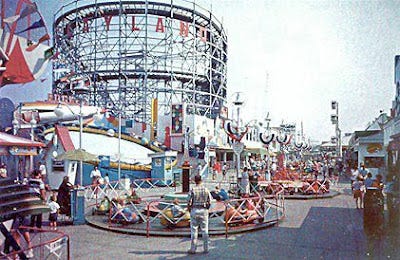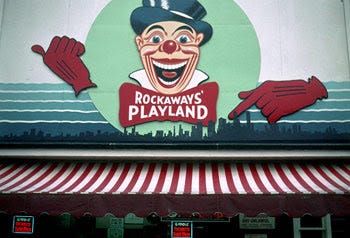Rockaway’s Playland, First Owned By a Roller Coaster Designer

The Queens amusement park, in its early days, was once owned by the developer of the modern roller coaster.
by Rich Watson
Rockaway’s Playland occupied a small area of land on Queens’ Rockaway peninsula. It was not as popular as the Coney Island area in Brooklyn, but it was a well-known destination in Queens for decades.
It was owned by the first designer of the roller coaster, a staple of amusement parks the world over.
LaMarcus Adna Thompson and the Switchback Railway
LaMarcus Adna Thompson made women’s stockings in the late nineteenth century. It was successful, but by the age of 35 he’d gotten out of the business for his health.
While visiting eastern Pennsylvania, he saw an unusual tourist attraction. The Mauch Chunk Switch Back Railway was a former coal transport railroad line, nine miles long, all downhill. Tourists rode it by the thousands every year.
There had been precedents for roller coasters:
In St. Petersburg, Russia in the seventeenth century, they built ice slides reinforced by wooden supports in the Russian Mountains.
In 1817, Paris’ Promenades-Aériennes used wheeled cars locked to the track.
In 1887, Spain’s “Russian Mountains of Belleville” contained 656 feet of track.
When Thompson saw the Mauch Chunk railway, inspiration hit him. He disliked the saloons and brothels of his time, which were popular. He craved something more family-friendly:
Many of the evils of society, much of the vice and crime which we deplore, come from the degrading nature of amusements… to substitute something better, something clean and wholesome, and persuade men to choose it, is worthy of all endeavor.
Thompson designed and obtained a patent for his own “Switchback Railway.” It opened at Coney Island in 1884. It was six hundred feet long and ran at about six to ten MPH. It would go one way up and down its slopes, then in reverse. At five cents a ride, he made six hundred dollars a day in profits.
Its popularity led to similar constructions, including circular roller coasters. Thompson also made improvements on the original, adding tunnels and lights as well as scenery. Eventually he formed his own company specifically to build scenic railways.
Here’s more about Thompson’s roller coaster development at Coney Island.
Thompson comes to the Rockaways
In 1901, Thompson bought two acres of land in Rockaway’s Seaside neighborhood from George Tilyou, who also owned Coney Island’s rebuilt Steeplechase Park.
Thompson’s Amusement Park opened approximately a year later.
At the time, it was one of several at the Rockaways. In 1903, a nearby ferry dock allowed visitors from other boroughs to come to the amusement park.
Thompson ran it until his death in 1919. His family kept it going until they sold it to Robert Katlin in 1927. He added an arena, gym and swimming pool. A year later, A. Joseph Geist bought it and rechristened the place Rockaway’s Playland.
Under his regime, Geist added, among other things, the Atom Smasher, Playland’s own roller coaster. Designed by Vernon Keenan, it was three thousand feet long and seventy feet high at its peak.
In 1952, it had its moment in the sun in a popular and innovative film.
The Atom Smasher in This is Cinerama
In the 1950s, Hollywood came up with a number of innovations designed to compete with the rise of television. One of them was Cinerama, a widescreen process that was the result of three images from three 35-millimeter projectors, displayed on one big, curved screen.
In 1952, the documentary This is Cinerama showed off the procedure for the first time, premiering in New York. Among the images used for the film was first-person footage of the Atom Smasher as it circled its track.
Redesign and expansion
In 1937, the city shut down Playland in order to build the Shore Front Parkway. This, combined with World War 2, led to a temporary shutdown and fewer rides.
By 1949, however, Geist added newer rides and better lights. Five years later, increased ferry service expanded Playland’s reach to Sheepshead Bay, Brooklyn and by 1964, to Westchester.
When Geist died in 1960, his son Richard took over operations until 1985, when a decline in attendance led to a permanent shutdown.
Generations of New Yorkers remember Playland as a fun alternative to Coney Island.

@byrichwatson
————————-
Did you go to Rockaway’s Playland?

